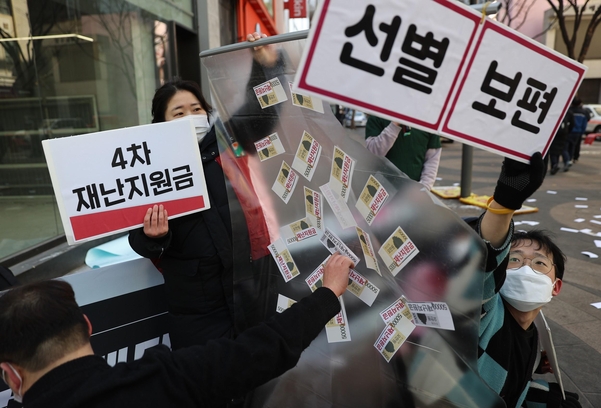Input 2021.02.21 10:01
Including 2~3 trillion won employment budget… 1.3 million public jobs are likely to increase further
The government and the ruling party are promisingly considering the 4th disaster subsidy plan, which divides the sales reduction rate of small business owners into 2-3 groups and provides differential support. In addition, it is observed that the size of the first supplementary budget for the 4th disaster support this year, including the employment subsidy system and additional expansion of public jobs, will be around 15 trillion won.
According to the Democratic Party along with the government on the 21st, the 4th disaster subsidy and the 1st supplementary plan are being discussed in this way. The differential support for small business owners according to the rate of decrease in sales is, for example, a method of giving 1 million won to small business owners whose sales declined within 10%, 1.5 million won to those whose sales decreased by 30%, and 2 million won to those who decreased by 50%.

In the first place, a plan to provide support at a fixed rate corresponding to the decrease in’income’ was reviewed, but this is a measure that reflects the reality of promptly paying support funds amid an insufficient income grading system.
Along with this, a plan to increase the base line for subsidy payments for general industries from less than 400 million won in annual sales to less than 1 billion won in annual sales is being considered. In addition, measures are being sought to increase the number of workers, which is the baseline for subsidies for small business owners, from’less than 5 (based on service industry)’. In this case, even those who slightly exceed the category of small business owners under the Enforcement Decree of the Basic Small Business Act can receive the small business subsidy.
The maximum level of subsidies for prohibited collective, restricted business, and general industries is expected to reach a conclusion in the process of discussions with the party this week, with 4 million to 5 million won.
Support for the underprivileged, such as special type workers (special advisors) and freelancers, is also under review. It is reported that there is a high possibility that the third subsidy payment method, which paid 500,000 won to existing beneficiaries and 1 million won to new beneficiaries, will be applied mutatis mutandis.
A plan is also under consideration to provide subsidies to borrowers such as tourist buses, self-employed people who have closed their business, and street vendors such as market stalls. There are many observations that they will be provided with a fixed amount of around 500,000 or 1 million won. Separate support programs are being sought for the culture, art, tourism, and travel industries that have been intensively affected by Corona 19.
It is observed that the total size of the first supplement will be adjusted between the party and the parties around 15 trillion won. It is the scale of the employment crisis overcome program, additional vaccine purchase costs, and quarantine costs added to the selected disaster subsidies that were initially discussed.
The government is reviewing an employment countermeasure budget of 2~3 trillion won to mitigate the employment shock. We are considering expanding the employment subsidy system, which gives a certain amount of subsidy per person when small business owners and small and medium-sized companies hire employees.
In addition, it is actively looking into ways to increase the targets and levels of employment maintenance subsidies and job security funds. The employment maintenance subsidy is a system in which the government pays part of the leave and leave allowance to business owners who took paid leave or leave due to deteriorating employment, etc.The government provided 1.3 trillion won in employment maintenance support this year, which is the amount of support last year. It is about half of the 1.61 million people, so it is expected to make an additional budget. A plan to increase the rate of support, which is 67% of the current leave allowance, is also discussed.
As such, the government is expected to increase the support for private employment maintenance and new recruitment, while also expanding the scale of public jobs directly hired by the government.
Initially, the government decided to provide more than 1.3 million public jobs this year, including 1042,000 direct jobs for the central government, 63,000 jobs for social services, and 177,000 jobs for local governments. As the employment situation is severe, the government is expected to increase the total size of public jobs by increasing the size of existing businesses such as jobs for the elderly and the disabled and social service jobs, and discovering new businesses such as jobs for women and youth.
The government is planning to come up with short-term measures to reduce the impact of employment caused by a sharp decline in the number of employed, as well as mid- and long-term measures to stabilize the job market. Mid- and long-term measures are expected to include expansion of youth entrepreneurship support programs, preventive measures for career breaks in women, and work-care balance measures.
